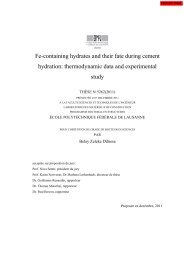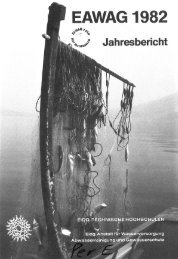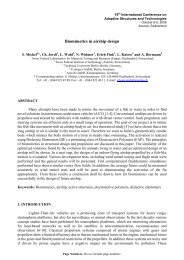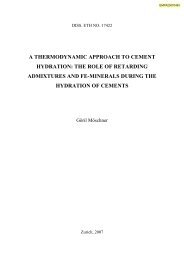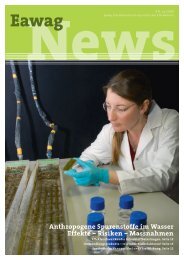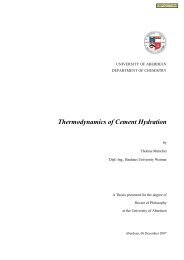Entire volume - Eawag
Entire volume - Eawag
Entire volume - Eawag
Create successful ePaper yourself
Turn your PDF publications into a flip-book with our unique Google optimized e-Paper software.
Ice and Climate<br />
About 80% of all the fresh water in the world is trapped as ice in<br />
the two polar regions. This ice is an exceptionally good environmental<br />
archive, containing invaluable clues to hundreds of thousands<br />
of years of climate history. Information on past climate can<br />
also be obtained from analyses of historical records of lake ice<br />
cover, such as those from the Lej da San Murezzan (the Lake of<br />
St. Moritz) in Switzerland and Lake Baikal in Siberia. A somewhat<br />
puzzling substance, which looks like ice, is methane hydrate. It<br />
normally lies buried in the deep-sea sediment, but slight changes<br />
in environmental conditions could cause it to rise to the sea surface,<br />
in which case it would be possible for large amounts of the<br />
greenhouse gas methane to enter the atmosphere, resulting in a<br />
serious acceleration of climate warming.<br />
Water conjures up images of babbling<br />
brooks and deep blue lakes reflecting snowcapped<br />
peaks. But water comes in other<br />
states, for example as a gas, when it is<br />
evaporated and transported from the sea<br />
onto the land, or as a solid, as snow and<br />
ice, when the temperature falls below zero.<br />
Considering all three states, most of us<br />
would be surprised to hear that most of the<br />
fresh water on the earth today is not found<br />
in rivers and lakes, but as ice (Fig. 1).<br />
Almost all of this frozen water – 99.4% –<br />
is located in the polar regions; i.e., in Antarctica<br />
and Greenland. The Antarctic ice mass<br />
is in parts 5 km thick, while in Greenland the<br />
ice depth can reach 3 km. The amount of ice<br />
in glaciers at lower latitudes accounts for<br />
only 0.6% of the total, and this proportion is<br />
unfortunately continually decreasing.<br />
Ice is, however, more than just frozen water.<br />
It provides us with a lot of invaluable information<br />
about current and past changes in<br />
the environment. Much of what was once<br />
trapped under the ice is just waiting to be<br />
brought out and investigated [1].<br />
Ice as an Archive<br />
There is practically nothing that does not<br />
leave a long-term record in the ice. But how<br />
does ice become such an archive? Land ice<br />
derives from snow. Freshly fallen snow is<br />
quite soft and light and contains about 90%<br />
air (Fig. 2). Within just a few days the ice<br />
crystals condense to firn, which, under the<br />
3 EAWAG news 58<br />
pressure of new snow layers, becomes<br />
harder and denser, until at a certain depth<br />
the firn crystals fuse to form ice (Fig. 3).<br />
Snow and ice, though, consist not just of<br />
water. As clouds form, atmospheric water<br />
vapor condenses most readily around<br />
aerosol particles, which can contain a wide<br />
variety of chemical substances. In addition,<br />
as a snow flake wafts down to earth, it can<br />
pick up a number of substances from the<br />
air. And finally, all sorts of things settle on<br />
freshly fallen snow: pollen and fine dust from<br />
volcanoes or deserts, for instance, as well<br />
as larger, more spectacular finds such as the<br />
stone-age man Ötzi or ice-age mammoths.<br />
The fact that all these environmental samples<br />
have been stored at very low temperatures<br />
is one of the main reasons that makes<br />
Groundwater and<br />
soil moisture<br />
22.4%<br />
Lakes and rivers<br />
0.6%<br />
Ice<br />
77%<br />
Fig. 1: Distribution of global fresh water. Water vapor<br />
in the atmosphere, which accounts for only 0.04% of<br />
the total, is not included.<br />
ice such an exceptional environmental<br />
archive [2].<br />
The GRIP Ice Core<br />
Drilling in the polar ice sheet places high<br />
demands on both drilling techniques and<br />
logistics. Setting up a drill camp and conducting<br />
a drilling operation at 3000 –4000 m<br />
above sea level more than a thousand kilometers<br />
from the nearest town during several<br />
summers is really only possible within the<br />
framework of an international operation. The<br />
first deep-drilling operations to reach the<br />
Snow<br />
Ice<br />
granulate<br />
Firn<br />
Glacial ice<br />
90% air<br />
50% air<br />
20–30% air<br />





